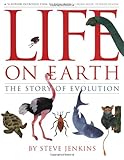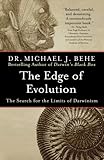|
|
Help |
| Home - Biology - Evolution (Books) | |
e99 Online Shopping Mall
|
|
Help |
| Home - Biology - Evolution (Books) | |
| Back | 21-40 of 98 | Next 20 |
click price to see details click image to enlarge click link to go to the store
| 21. Spiritual Evolution: How We Are Wired for Faith, Hope, and Love by George Vaillant | |
 | Paperback: 256
Pages
(2009-06-09)
list price: US$15.00 -- used & new: US$5.99 (price subject to change: see help) Asin: 0767926587 Average Customer Review: Canada | United Kingdom | Germany | France | Japan |
|
Editorial Review Product Description Customer Reviews (15)
| |
| 22. Radical Evolution: The Promise and Peril of Enhancing Our Minds, Our Bodies -- and What It Means to Be Human by Joel Garreau | |
 | Paperback: 400
Pages
(2006-05-09)
list price: US$16.99 -- used & new: US$8.68 (price subject to change: see help) Asin: 0767915038 Average Customer Review: Canada | United Kingdom | Germany | France | Japan |
|
Editorial Review Product Description Customer Reviews (38)
| |
| 23. Evolution in Four Dimensions: Genetic, Epigenetic, Behavioral, and Symbolic Variation in the History of Life (Life and Mind: Philosophical Issues in Biology and Psychology) by Eva Jablonka, Marion J. Lamb | |
 | Paperback: 474
Pages
(2006-10-01)
list price: US$20.95 -- used & new: US$10.94 (price subject to change: see help) Asin: 0262600692 Average Customer Review: Canada | United Kingdom | Germany | France | Japan |
|
Editorial Review Product Description Customer Reviews (17)
| |
| 24. Evolution Rx: A Practical Guide to Harnessing Our Innate Capacity for Health and Healing by William Meller | |
 | Paperback: 336
Pages
(2010-04-06)
list price: US$15.95 -- used & new: US$6.38 (price subject to change: see help) Asin: B0045EPD04 Average Customer Review: Canada | United Kingdom | Germany | France | Japan |
Customer Reviews (22)
| |
| 25. The Evolution of Useful Things: How Everyday Artifacts-From Forks and Pins to Paper Clips and Zippers-Came to be as They are by Henry Petroski | |
 | Paperback: 304
Pages
(1994-02-01)
list price: US$14.95 -- used & new: US$2.28 (price subject to change: see help) Asin: 0679740392 Average Customer Review: Canada | United Kingdom | Germany | France | Japan |
|
Editorial Review Product Description Customer Reviews (30)
| |
| 26. Brilliant: The Evolution of Artificial Light by Jane Brox | |
 | Hardcover: 368
Pages
(2010-07-08)
list price: US$25.00 -- used & new: US$12.50 (price subject to change: see help) Asin: 0547055277 Average Customer Review: Canada | United Kingdom | Germany | France | Japan |
|
Editorial Review Product Description Amazon Exclusive: A Letter from Jane Brox, Author of Brilliant: The Evolution of Artificial Light (Photo © Luc Demers) Customer Reviews (12)
| |
| 27. Life on Earth: The Story of Evolution by Steve Jenkins | |
 | Hardcover: 40
Pages
(2002-10-28)
list price: US$16.00 -- used & new: US$9.78 (price subject to change: see help) Asin: 0618164766 Average Customer Review: Canada | United Kingdom | Germany | France | Japan |
|
Editorial Review Product Description Customer Reviews (12)
| |
| 28. Thank God for Evolution: How the Marriage of Science and Religion Will Transform Your Life and Our World by Michael Dowd | |
 | Paperback: 448
Pages
(2009-04-28)
list price: US$16.00 -- used & new: US$4.75 (price subject to change: see help) Asin: B002PJ4FU0 Average Customer Review: Canada | United Kingdom | Germany | France | Japan |
|
Editorial Review Product Description Customer Reviews (66)
| |
| 29. The Edge of Evolution: The Search for the Limits of Darwinism by Michael J. Behe | |
 | Paperback: 336
Pages
(2008-06-17)
list price: US$15.00 -- used & new: US$2.68 (price subject to change: see help) Asin: 0743296222 Average Customer Review: Canada | United Kingdom | Germany | France | Japan |
|
Editorial Review Product Description Now, in his long-awaited follow-up, Behe presents far more than a challenge to Darwinism: He presents the evidence of the genetics revolution -- the first direct evidence of nature's mutational pathways -- to radically redefine the debate about Darwinism. How much of life does Darwin's theory explain? Most scientists believe it accounts for everything from the machinery of the cell to the history of life on earth. Darwin's ideas have been applied to law, culture, and politics. But Darwin's theory has been proven only in one sense: There is little question that all species on earth descended from a common ancestor. Overwhelming anatomical, genetic, and fossil evidence exists for that claim. But the crucial question remains: How did it happen? Darwin's proposed mechanism -- random mutation and natural selection -- has been accepted largely as a matter of faith and deduction or, at best, circumstantial evidence. Only now, thanks to genetics, does science allow us to seek direct evidence. The genomes of many organisms have been sequenced, and the machinery of the cell has been analyzed in great detail. The evolutionary responses of microorganisms to antibiotics and humans to parasitic infections have been traced over tens of thousands of generations. As a result, for the first time in history Darwin's theory can be rigorously evaluated. The results are shocking. Although it can explain marginal changes in evolutionary history, random mutation and natural selection explain very little of the basic machinery of life. The "edge" of evolution, a line that defines the border between random and nonrandom mutation, lies very far from where Darwin pointed. Behe argues convincingly that most of the mutations that have defined the history of life on earth have been nonrandom. Although it will be controversial and stunning, this finding actually fits a general pattern discovered by other branches of science in recent decades: The universe as a whole was fine-tuned for life. From physics to cosmology to chemistry to biology, life on earth stands revealed as depending upon an endless series of unlikely events. The clear conclusion: The universe was designed for life. Customer Reviews (119)
| |
| 30. Origins: Human Evolution Revealed by Douglas Palmer | |
 | Hardcover: 256
Pages
(2010-09-20)
list price: US$34.99 -- used & new: US$15.49 (price subject to change: see help) Asin: 1845334744 Canada | United Kingdom | Germany | France | Japan |
|
Editorial Review Product Description | |
| 31. Spent: Sex, Evolution, and Consumer Behavior by Geoffrey Miller | |
 | Hardcover: 384
Pages
(2009-05-14)
list price: US$26.95 -- used & new: US$5.41 (price subject to change: see help) Asin: B002ZNJWHW Average Customer Review: Canada | United Kingdom | Germany | France | Japan |
|
Editorial Review Product Description Customer Reviews (25)
| |
| 32. Hard Sell: The Evolution of a Viagra Salesman by Jamie Reidy | |
 | Hardcover: 224
Pages
(2005-03-01)
list price: US$19.95 -- used & new: US$3.79 (price subject to change: see help) Asin: 0740750399 Average Customer Review: Canada | United Kingdom | Germany | France | Japan |
|
Editorial Review Product Description Jamie Reidy is to the pharmaceutical business what Jerry Maguire was to professional sports and Frank Abagnale (Catch Me If You Can) was to bank fraud. He's the guy who's been there, done that, and walked away with the insider stories. You'll find yourself rooting for Reidy and at the same time, you'll be shocked by the realities of the world that paid his salary. Hard Sell is a witty expose; of an industry that touches nearly everyone in contemporary America. It reveals the questionable practices of drug reps, nurses, and even physicians. Reidy traces his ups and downs as a rep for giant drug manufacturer Pfizer, maker of some of the most widely prescribed and used drugs in existence, including Viagra. With equal parts self-confidence and self-mockery, Reidy tells it like it is in the drug-selling trenches that are our local doctors' offices. The result is a funny and fascinating book. Customer Reviews (31)
| |
| 33. Our Family Tree: An Evolution Story by Lisa Westberg Peters | |
 | Hardcover: 48
Pages
(2003-04-01)
list price: US$17.00 -- used & new: US$8.74 (price subject to change: see help) Asin: 0152017720 Average Customer Review: Canada | United Kingdom | Germany | France | Japan |
|
Editorial Review Product Description Customer Reviews (17)
| |
| 34. Evolution for Everyone: How Darwin's Theory Can Change the Way We Think About Our Lives by David Sloan Wilson | |
 | Paperback: 400
Pages
(2007-12-26)
list price: US$15.00 -- used & new: US$8.42 (price subject to change: see help) Asin: 0385340923 Average Customer Review: Canada | United Kingdom | Germany | France | Japan |
|
Editorial Review Product Description Customer Reviews (38)
| |
| 35. The Art of Plant Evolution by W. John Kress, Shirley Sherwood | |
 | Paperback: 320
Pages
(2010-04-15)
list price: US$41.00 -- used & new: US$27.06 (price subject to change: see help) Asin: 1842464175 Average Customer Review: Canada | United Kingdom | Germany | France | Japan |
|
Editorial Review Product Description This beautiful mix of art and science offers a breathtaking look at the way that contemporary scientific discoveries are changing our understanding of plants and plant evolution. Nearly one hundred and fifty paintings, by eighty-four artists, are reproduced in full color to present a sweeping overview of the evolution of plants worldwide. The paintings cover a wide range of plants, including ferns, fungi, conifers, algae, mosses, and a rich bounty of flowering plants; accompanying each painting is up-to-date evolutionary information—drawn from recent DNA analysis—plus observations by each of the artists and details about modern plant classification. Written for the nonspecialist, The Art of Plant Evolution is sure to enchant inquisitive green thumbs and gardeners. Customer Reviews (2)
| |
| 36. Evolution of Physics by Albert Einstein, Leopold Infeld | |
 | Paperback: 336
Pages
(1967-10-30)
list price: US$15.00 -- used & new: US$4.99 (price subject to change: see help) Asin: 0671201565 Average Customer Review: Canada | United Kingdom | Germany | France | Japan |
|
Editorial Review Product Description Customer Reviews (16)
| |
| 37. Darwin's Armada: Four Voyages and the Battle for the Theory of Evolution by Iain McCalman | |
 | Paperback: 423
Pages
(2010-11-15)
list price: US$18.95 -- used & new: US$12.25 (price subject to change: see help) Asin: 0393338770 Average Customer Review: Canada | United Kingdom | Germany | France | Japan |
|
Editorial Review Product Description Customer Reviews (5)
| |
| 38. Evolution of the Insects (Cambridge Evolution Series) by David Grimaldi, Michael S. Engel | |
 | Hardcover: 772
Pages
(2005-05-16)
list price: US$95.00 -- used & new: US$74.85 (price subject to change: see help) Asin: 0521821495 Average Customer Review: Canada | United Kingdom | Germany | France | Japan |
|
Editorial Review Product Description Customer Reviews (14)
| |
| 39. Incredible Creatures that Defy Evolution 1 | |
 | DVD-ROM:
Pages
-- used & new: US$19.24 (price subject to change: see help) Asin: 0970742215 Average Customer Review: Canada | United Kingdom | Germany | France | Japan |
Customer Reviews (49)
| |
| 40. The Evolution of Man - Volume 1 by Ernst Heinrich Philipp August Haeckel | |
 | Paperback: 182
Pages
(2010-03-07)
list price: US$26.81 -- used & new: US$24.12 (price subject to change: see help) Asin: 1153701952 Canada | United Kingdom | Germany | France | Japan |
|
Editorial Review Product Description | |
| Back | 21-40 of 98 | Next 20 |